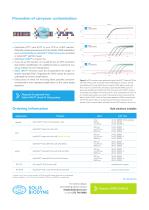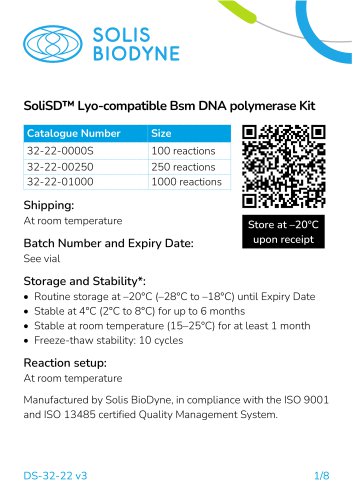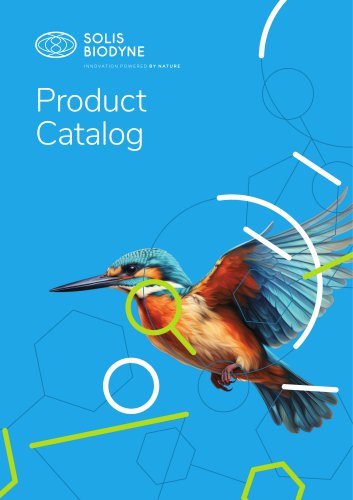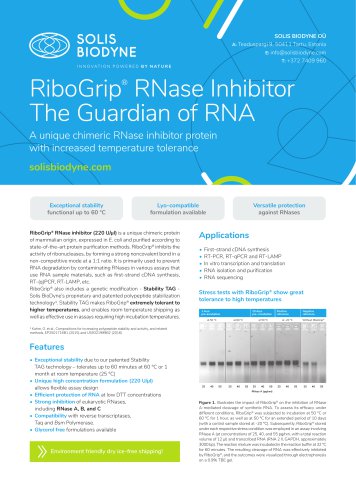 Website:
Solis BioDyne
Website:
Solis BioDyne
Catalog excerpts

SOLIS BIODYNE OÜ E: info@solisbiodyne.com T: +372 7409 960 F: +372 7402 079 Unique enzyme with Stability TAG technology for increased temperature tolerance solisbiodyne.com Salini UNG™ Uracil-N-Glycosylase is a unique heat-labile enzyme. The protein sequence originates from the bacteria genus Salinivibrio which is frequently found in hypersaline environments. Uracil-N-Glycosylase (UNG) efficiently eliminates uracil from single- or doublestranded DNA by catalyzing the hydrolysis of the N-glycosylic bond and leaving an abasic site. This property is widely used as a part of PCR carryover contamination prevention strategy. Salini UNG™ (Figure 1) is a genetically modified enzyme including a Stability TAG - Solis BioDyne’s proprietary and patented polypeptide stabilization technology that makes all our proteins extremely stable at room temperature [1,2,3]. [1] Kahre, O. et al., Compositions for increasing polypeptide stability and activity, and related methods, EP2501716B1 (2015) and US9321999B2 (2016). [2] Jumper, J. et al. Highly accurate protein structure prediction with AlphaFold. Nature (2021). [3] Varadi, M. et al. AlphaFold Protein Structure Database: massively expanding the structural coverage of protein-sequence space with high-accuracy models. Nucleic Acids Research (2021). Figure 1. 3D model of Salini UNG™ Uracil-NGlycosylase protein structure with the Stability TAG. Protein structure was predicted with AlphaFold 2. Widely used to eliminate carryover contamination in PCR and LAMP Enhancer of cloning efficiency of PCR products Site-directed mutagenesis As a probe for protein-DNA interaction studies Glycosylase-mediated single nucleotide polymorphism detection (GMPD) Study of DNA repair and mutation detection SNP genotyping • Stable at 25°C for at least 2 months and at 37°C 2 weeks • Heat-labile (compatible with Sanger sequencing). No reactivation is detected after heat inactivation • Fast 30 sec reaction time • Tolerant to common inhibitors • Reaction set-up and shipment without ice • Glycerol-free formulation is available Salini UNG™ heat inactivated for 5 min at 70°C Salini UNG™ no heat treatment Figure 2. Heat inactivation of Salini UNG™ Uracil-NGlycosylase. UNG activity is measured at 37°C for 40 minutes using Bio-Rad CFX96 platform by the release of fluorescence from a uracil containing probe labeled with a FAM fluorophore and a quencher. In a resting state the probe forms a duplex and FAM fluorescence is quenched. An active UNG cleaves uracil, the duplex dissociates and FAM fluorescence is emitted. To test the inactivation of the enzyme, Salini UNG™ was heat-treated at 70°C for 5 minutes. No reactivation was detected after storing the heat-treated samples at 4
Open the catalog to page 1
Prevention of carryover contamination Amplification 10⁴ Request for glycerol-free Salini UNG™ Uracil-N-Glycosylase +UNG +CONTAMINATION • Substitute dTTP with dUTP in your PCR or LAMP reaction. Preferably choose polymerases that can tolerate 100% substitution such as Solis BioDyne SolisFAST® DNA Polymerase (included in SolisFAST® (q)PCR mixes). • Add Salini UNG™ to master mix. • If you set up the reaction on ice add 30 sec at 25°C treatment step before amplification. No additional step is required if you set up reaction at room temperature. • Salini UNG™ removes uracil (U) incorporated into...
Open the catalog to page 2All Solis BioDyne catalogs and technical brochures
-
Product catalog 24/25
58 Pages
-
SolisFAST® qPCR range
2 Pages
-
SolisFAST® Probe qPCR Mix
2 Pages
-
SolisFAST® Master Mix
2 Pages
-
SOLIScript® 1-step Probe Kit
1 Pages

















